fuel type TOYOTA 86 2023 Owners Manual
[x] Cancel search | Manufacturer: TOYOTA, Model Year: 2023, Model line: 86, Model: TOYOTA 86 2023Pages: 449, PDF Size: 8.5 MB
Page 13 of 449
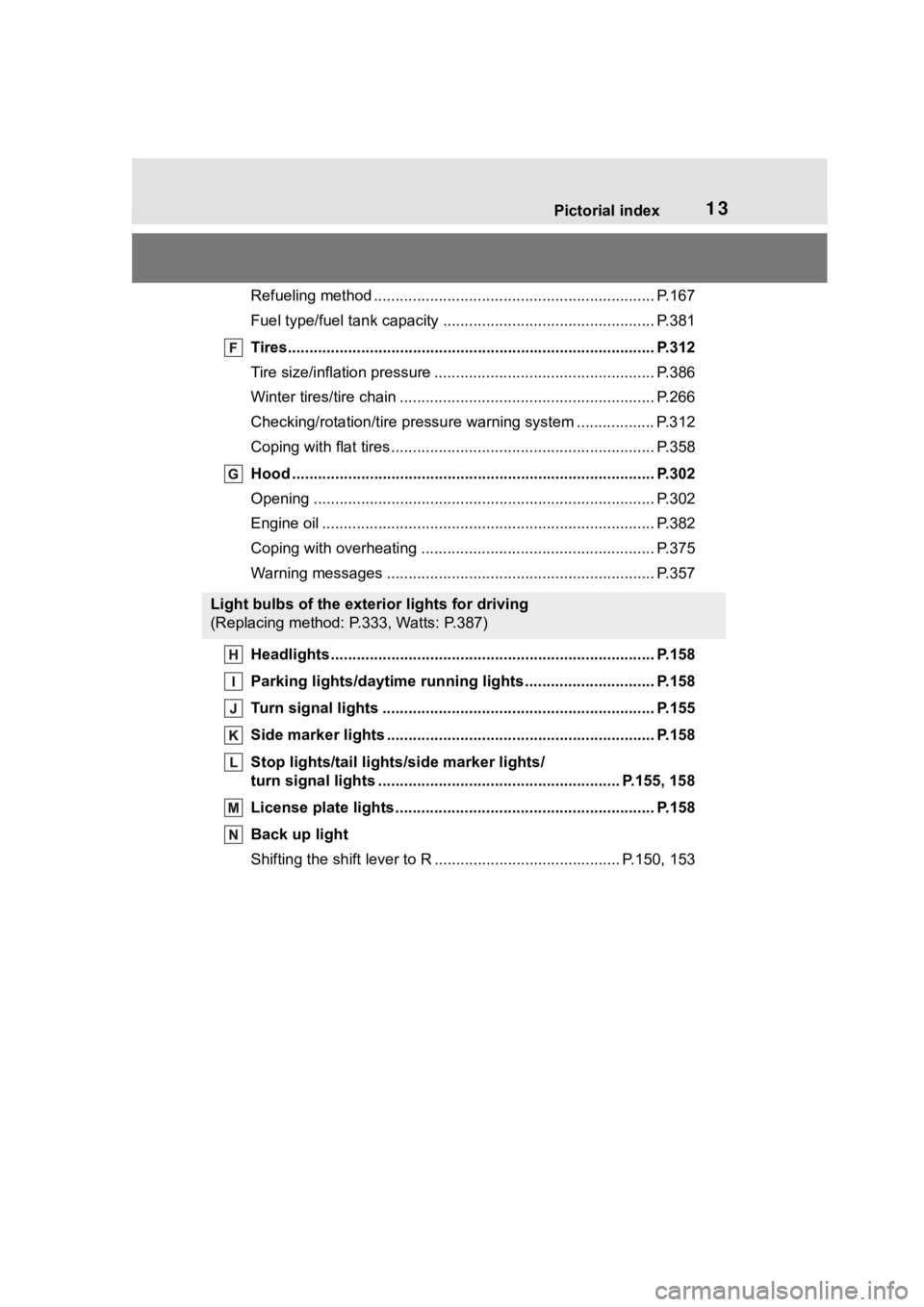
13Pictorial index
Refueling method ................................................................. P.167
Fuel type/fuel tan k capacity ................................... .............. P.381
Tires.......................................................... ........................... P.312
Tire size/inflation pressure ................................... ................ P.386
Winter tires/tire chain ........................................ ................... P.266
Checking/rotation/tire pressur e warning system ..................P.312
Coping with flat tires......................................... .................... P.358
Hood ........................................................... ......................... P.302
Opening ............................................................................... P.302
Engine oil ..................................................... ........................ P.382
Coping with overheating ...................................................... P.375
Warning messages ............................................... ............... P.357
Headlights..................................................... ...................... P.158
Parking lights/dayt ime running lights .......................... .... P.158
Turn signal lights ............................................. .................. P.155
Side marker lights ............................................. ................. P.158
Stop lights/tail light s/side marker lights/
turn signal lights ........................................................ P.155, 158
License plate lights........................................... ................. P.158
Back up light
Shifting the shift lever to R ........................................... P.150, 153
Light bulbs of the exterior lights for driving
(Replacing method: P.333, Watts: P.387)
Page 134 of 449
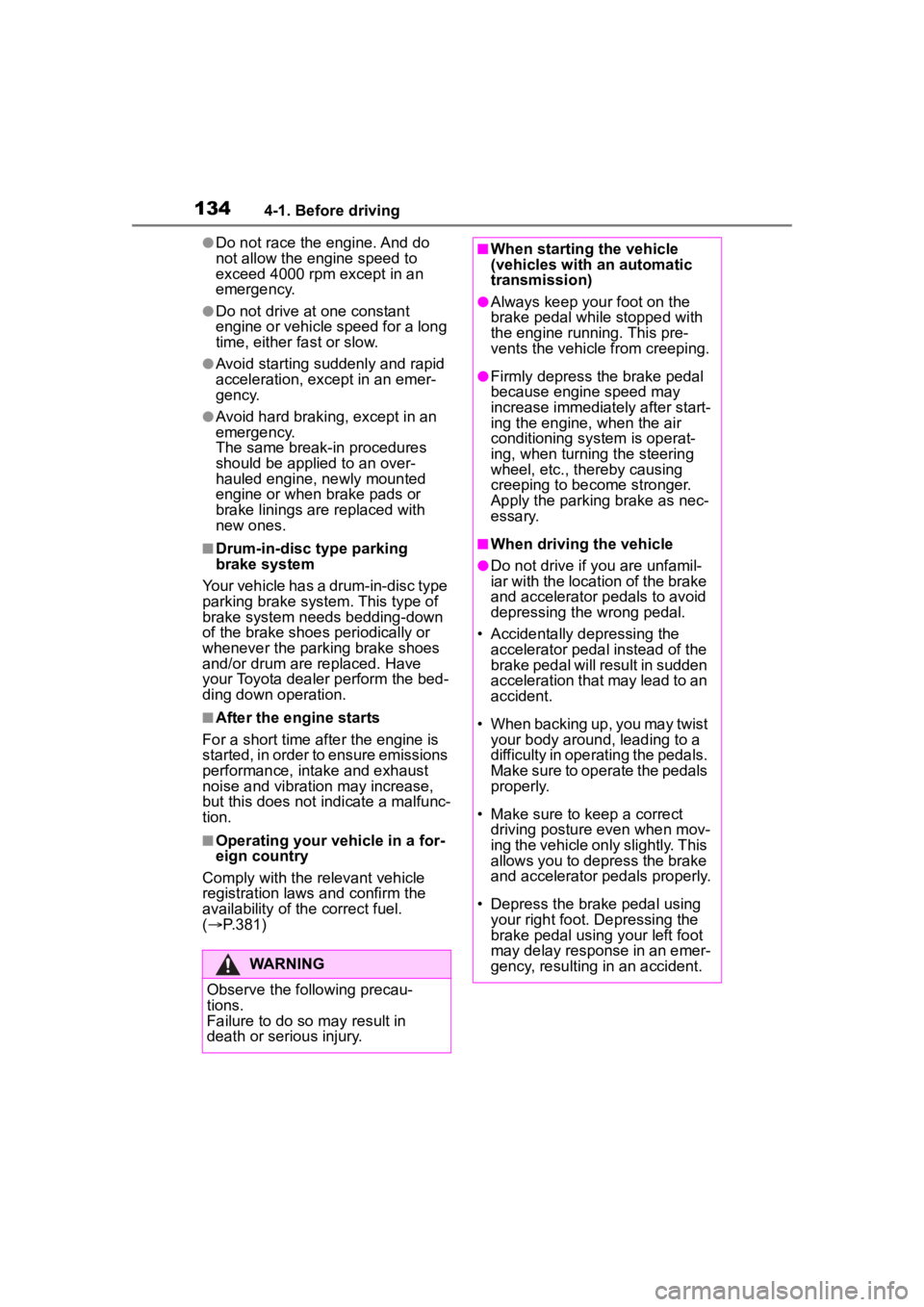
1344-1. Before driving
●Do not race the engine. And do
not allow the engine speed to
exceed 4000 rpm except in an
emergency.
●Do not drive at one constant
engine or vehicle speed for a long
time, either fast or slow.
●Avoid starting suddenly and rapid
acceleration, except in an emer-
gency.
●Avoid hard braking, except in an
emergency.
The same break-in procedures
should be applied to an over-
hauled engine, newly mounted
engine or when brake pads or
brake linings are replaced with
new ones.
■Drum-in-disc type parking
brake system
Your vehicle has a drum-in-disc type
parking brake system. This type of
brake system needs bedding-down
of the brake shoes periodically or
whenever the parking brake shoes
and/or drum are replaced. Have
your Toyota dealer perform the bed-
ding down operation.
■After the engine starts
For a short time after the engine is
started, in order to ensure emissions
performance, intake and exhaust
noise and vibration may increase,
but this does not indicate a malfunc-
tion.
■Operating your vehicle in a for-
eign country
Comply with the relevant vehicle
registration laws and confirm the
availability of the correct fuel.
( P.381)
WARNING
Observe the following precau-
tions.
Failure to do so m ay result in
death or serious injury.
■When starting the vehicle
(vehicles with an automatic
transmission)
●Always keep your foot on the
brake pedal while stopped with
the engine running. This pre-
vents the vehicle from creeping.
●Firmly depress the brake pedal
because engine speed may
increase immediately after start-
ing the engine, when the air
conditioning system is operat-
ing, when turning the steering
wheel, etc., thereby causing
creeping to become stronger.
Apply the parkin g brake as nec-
essary.
■When driving the vehicle
●Do not drive if you are unfamil-
iar with the location of the brake
and accelerator pedals to avoid
depressing the wrong pedal.
• Accidentally depressing the accelerator pedal instead of the
brake pedal will result in sudden
acceleration that may lead to an
accident.
• When backing up, you may twist your body around, leading to a
difficulty in operating the pedals.
Make sure to operate the pedals
properly.
• Make sure to keep a correct driving posture even when mov-
ing the vehicle only slightly. This
allows you to depress the brake
and accelerator pedals properly.
• Depress the brake pedal using your right foot. Depressing the
brake pedal using your left foot
may delay response in an emer-
gency, resulting in an accident.
Page 167 of 449
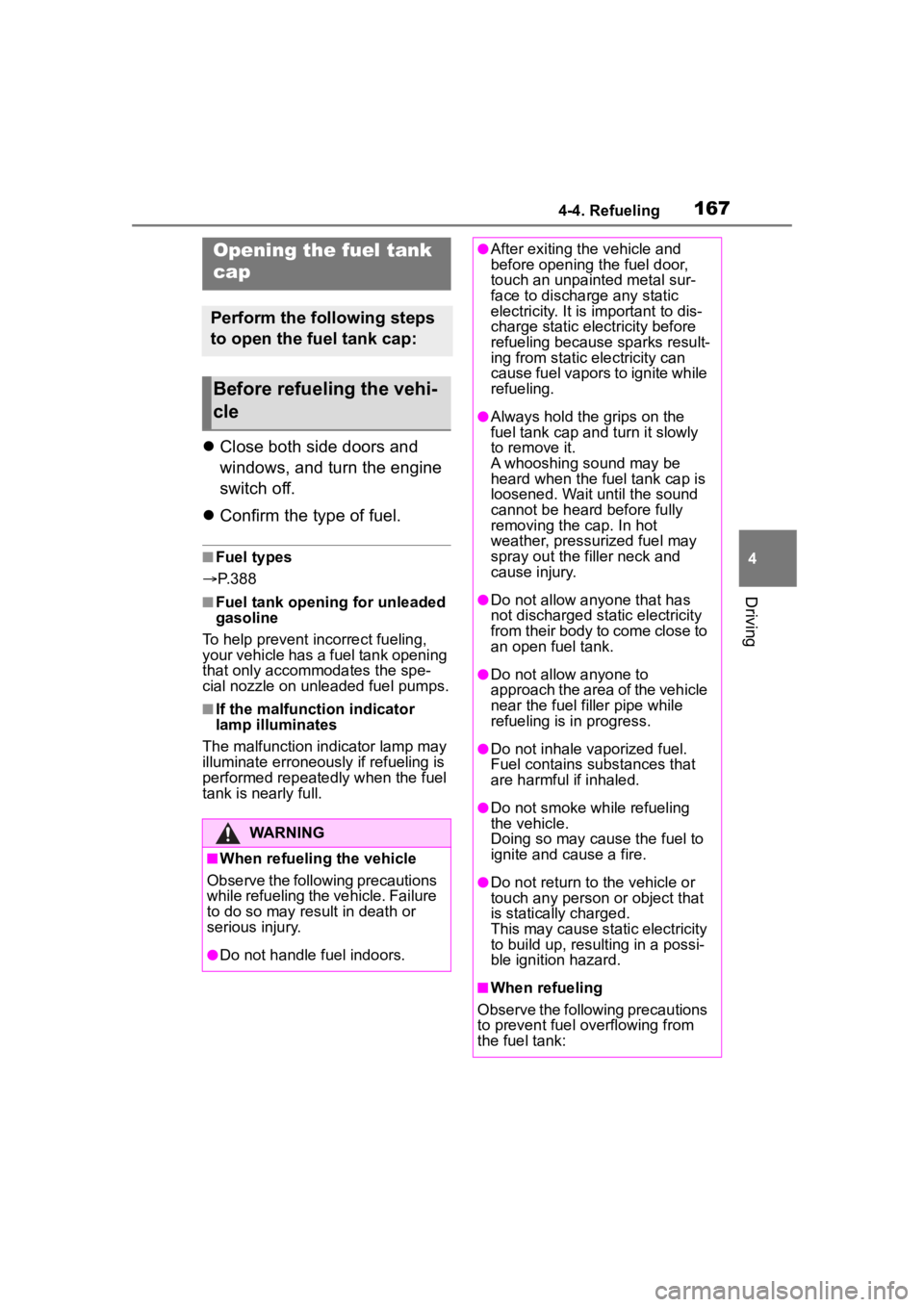
1674-4. Refueling
4
Driving
4-4.Refueling
Close both side doors and
windows, and turn the engine
switch off.
Confirm the type of fuel.
■Fuel types
P. 3 8 8
■Fuel tank opening for unleaded
gasoline
To help prevent incorrect fueling,
your vehicle has a fuel tank opening
that only accommodates the spe-
cial nozzle on unle aded fuel pumps.
■If the malfunction indicator
lamp illuminates
The malfunction indicator lamp may
illuminate erroneous ly if refueling is
performed repeatedly when the fuel
tank is nearly full.
Opening the fuel tank
cap
Perform the following steps
to open the fuel tank cap:
Before refueling the vehi-
cle
WARNING
■When refueling the vehicle
Observe the following precautions
while refueling the vehicle. Failure
to do so may result in death or
serious injury.
●Do not handle fuel indoors.
●After exiting the vehicle and
before opening the fuel door,
touch an unpainted metal sur-
face to discharge any static
electricity. It is important to dis-
charge static electricity before
refueling because sparks result-
ing from static electricity can
cause fuel vapors to ignite while
refueling.
●Always hold the grips on the
fuel tank cap and turn it slowly
to remove it.
A whooshing sound may be
heard when the f uel tank cap is
loosened. Wait until the sound
cannot be heard before fully
removing the cap. In hot
weather, pressurized fuel may
spray out the filler neck and
cause injury.
●Do not allow anyone that has
not discharged static electricity
from their body to come close to
an open fuel tank.
●Do not allow anyone to
approach the area of the vehicle
near the fuel f iller pipe while
refueling is in progress.
●Do not inhale vaporized fuel.
Fuel contains substances that
are harmful if inhaled.
●Do not smoke while refueling
the vehicle.
Doing so may cause the fuel to
ignite and cause a fire.
●Do not return to the vehicle or
touch any person or object that
is statically charged.
This may cause static electricity
to build up, resulting in a possi-
ble ignition hazard.
■When refueling
Observe the following precautions
to prevent fuel overflowing from
the fuel tank:
Page 342 of 449
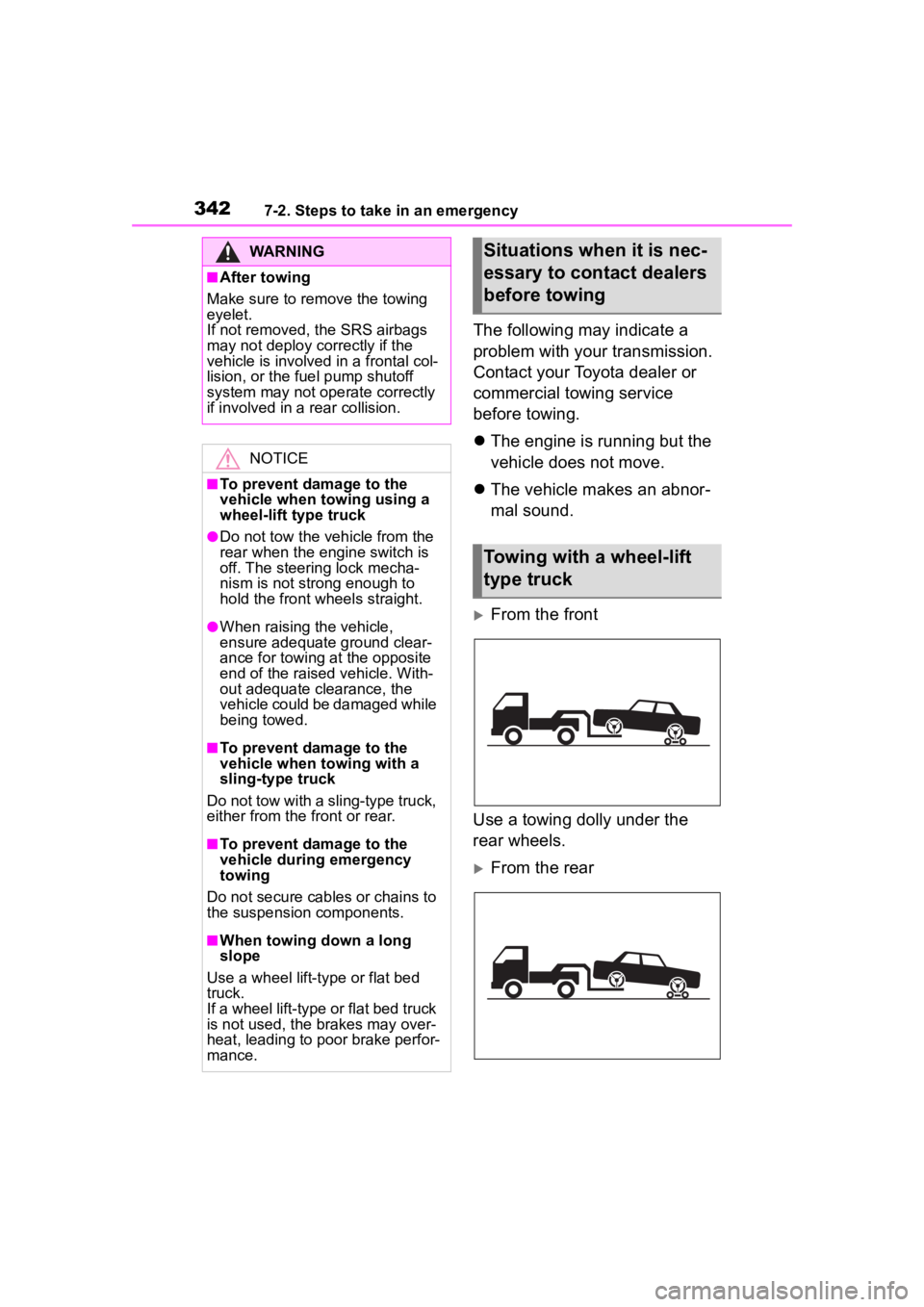
3427-2. Steps to take in an emergency
The following may indicate a
problem with your transmission.
Contact your Toyota dealer or
commercial towing service
before towing.
The engine is running but the
vehicle does not move.
The vehicle makes an abnor-
mal sound.
From the front
Use a towing dolly under the
rear wheels.
From the rear
WARNING
■After towing
Make sure to remove the towing
eyelet.
If not removed, the SRS airbags
may not deploy correctly if the
vehicle is involved in a frontal col-
lision, or the fuel pump shutoff
system may not operate correctly
if involved in a rear collision.
NOTICE
■To prevent damage to the
vehicle when towing using a
wheel-lift type truck
●Do not tow the vehicle from the
rear when the engine switch is
off. The steering lock mecha-
nism is not strong enough to
hold the front wheels straight.
●When raising the vehicle,
ensure adequate ground clear-
ance for towing at the opposite
end of the raised vehicle. With-
out adequate clearance, the
vehicle could be damaged while
being towed.
■To prevent damage to the
vehicle when towing with a
sling-type truck
Do not tow with a sling-type truck,
either from the front or rear.
■To prevent damage to the
vehicle during emergency
towing
Do not secure cables or chains to
the suspension components.
■When towing down a long
slope
Use a wheel lift-type or flat bed
truck.
If a wheel lift-type or flat bed truck
is not used, the brakes may over-
heat, leading to poor brake perfor-
mance.
Situations when it is nec-
essary to contact dealers
before towing
Towing with a wheel-lift
type truck
Page 381 of 449
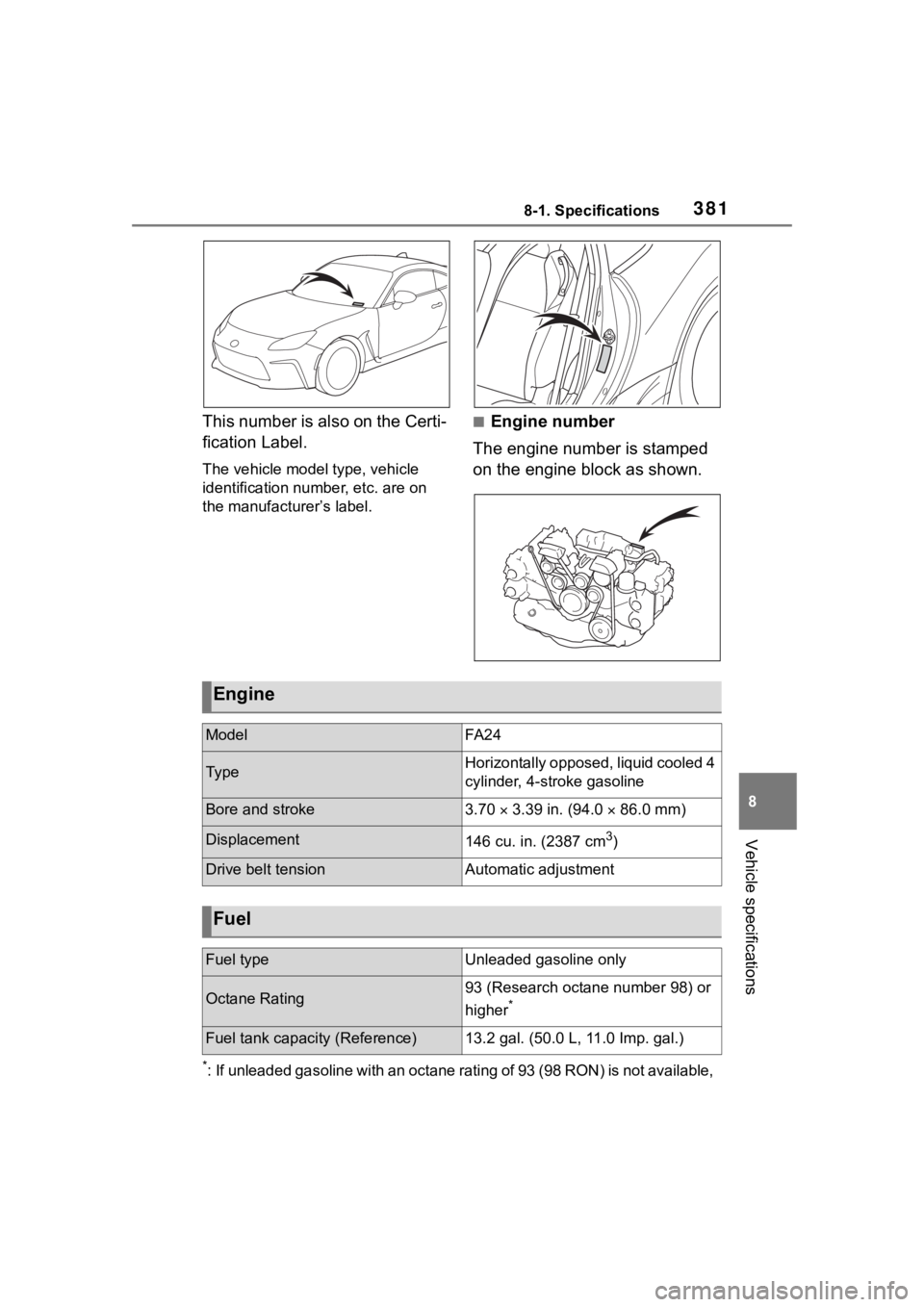
3818-1. Specifications
8
Vehicle specifications
This number is also on the Certi-
fication Label.
The vehicle model type, vehicle
identification number, etc. are on
the manufacturer’s label.
■Engine number
The engine number is stamped
on the engine block as shown.
*: If unleaded gasoline with an octane rating of 93 (98 RON) is not available,
Engine
ModelFA 2 4
Ty p eHorizontally opposed, liquid cooled 4
cylinder, 4-stroke gasoline
Bore and stroke3.70 3.39 in. (94.0 86.0 mm)
Displacement146 cu. in. (2387 cm3)
Drive belt tensionAutomatic adjustment
Fuel
Fuel typeUnleaded gasoline only
Octane Rating93 (Research octane number 98) or
higher
*
Fuel tank capacity (Reference)13.2 gal. (50.0 L, 11.0 Imp. gal.)
Page 384 of 449
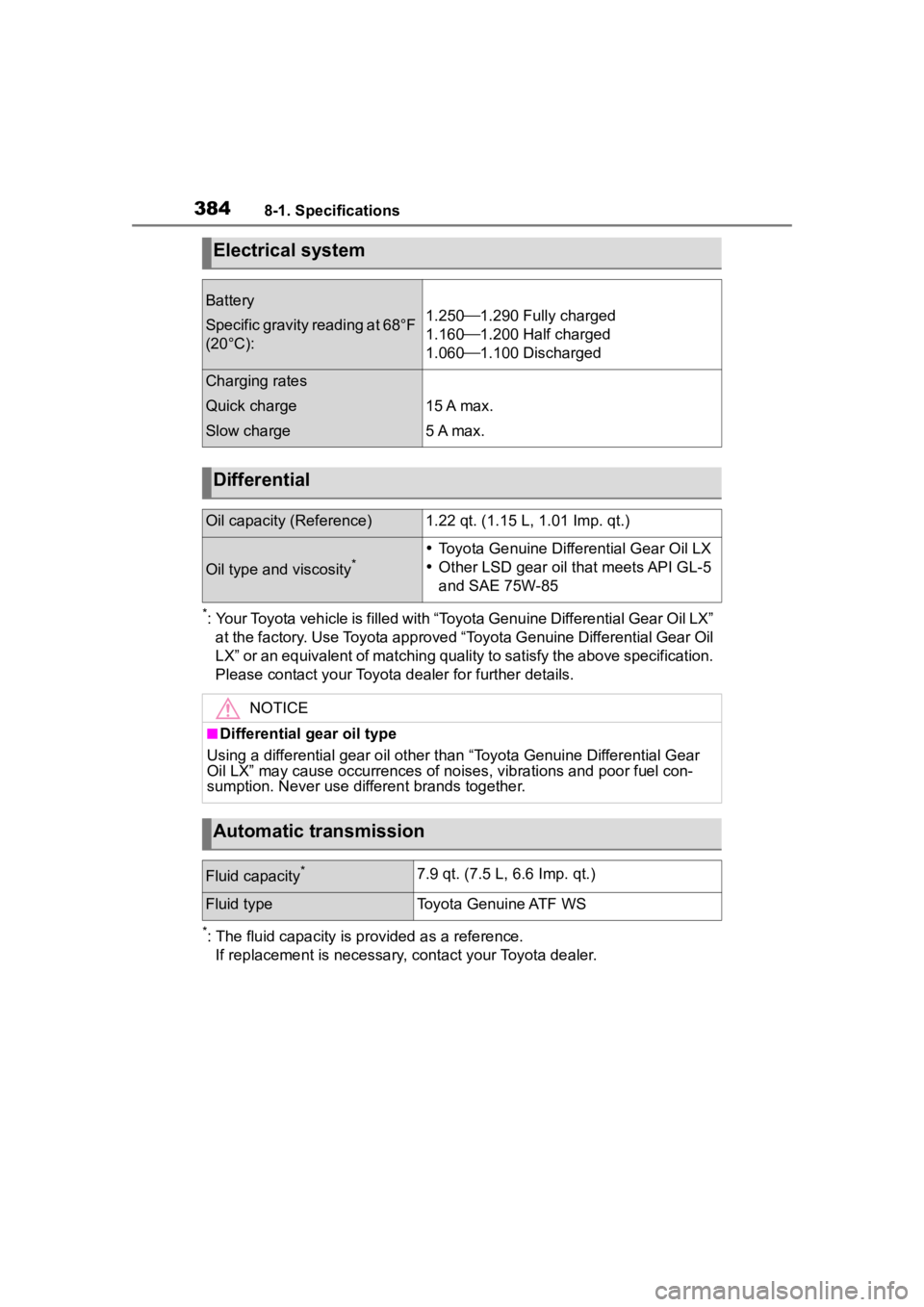
3848-1. Specifications
*: Your Toyota vehicle is filled with “Toyota Genuine Differential Gear Oil LX”
at the factory. Use Toyota approved “Toyota Genuine Differentia l Gear Oil
LX” or an equivalent of matching quality to satisfy the above s pecification.
Please contact your Toyota dealer for further details.
*: The fluid capacity is p rovided as a reference.
If replacement is necessary, contact your Toyota dealer.
Electrical system
Battery
Specific gravity reading at 68°F
(20°C):1.2501.290 Fully charged
1.1601.200 Half charged
1.0601.100 Discharged
Charging rates
Quick charge
Slow charge
15 A max.
5 A max.
Differential
Oil capacity (Reference)1.22 qt. (1.15 L, 1.01 Imp. qt.)
Oil type and viscosity* Toyota Genuine Differential Gear Oil LX
Other LSD gear oil that meets API GL-5
and SAE 75W-85
NOTICE
■Differential gear oil type
Using a differential gear oil ot her than “Toyota Genuine Differ ential Gear
Oil LX” may cause occurrences of noises, vibrations and poor fuel con-
sumption. Never use different brands together.
Automatic transmission
Fluid capacity*7.9 qt. (7.5 L, 6.6 Imp. qt.)
Fluid typeToyota Genuine ATF WS
Page 385 of 449

3858-1. Specifications
8
Vehicle specifications
*: The recommended oil grade is API GL-4. However, API GL-3 can also be
used.
NOTICE
■Transmission fluid type
Using automatic transmission fluid other than “TOYOTA Genuine A TF
WS” may cause deterioration in shift quality, locking up of your transmis-
sion accompanied by vibration, a nd ultimately damage the automatic
transmission of your vehicle.
Manual transmission
Fluid capacity*2.3 qt. (2.2 L, 1.9 Imp. qt.)
Fluid type
Use either of the following:
“MT GEAR OIL LV 75W”
Other gear oil that meets API GL-4
* and
SAE 75W specifications
NOTICE
■Transmission fluid type
If oil other than “MT GEAR OIL LV 75W” is used, the following m ay be
experienced:
●The overall performance and function of the transmission may be
adversely affected.
●Rattling noises may occur during idling and fuel consumption may
increase.
Never use different brands together.
Clutch
Pedal free play0.17 0.65 in. (4.3 16.4 mm)
Fluid typeSAE J1703 or FMVSS No.116 DOT 3
Brakes
Pedal clearance*12.91 in. (74 mm) Min.
Pedal free play0.0200.059 in. (0.51.5 mm)
Page 389 of 449
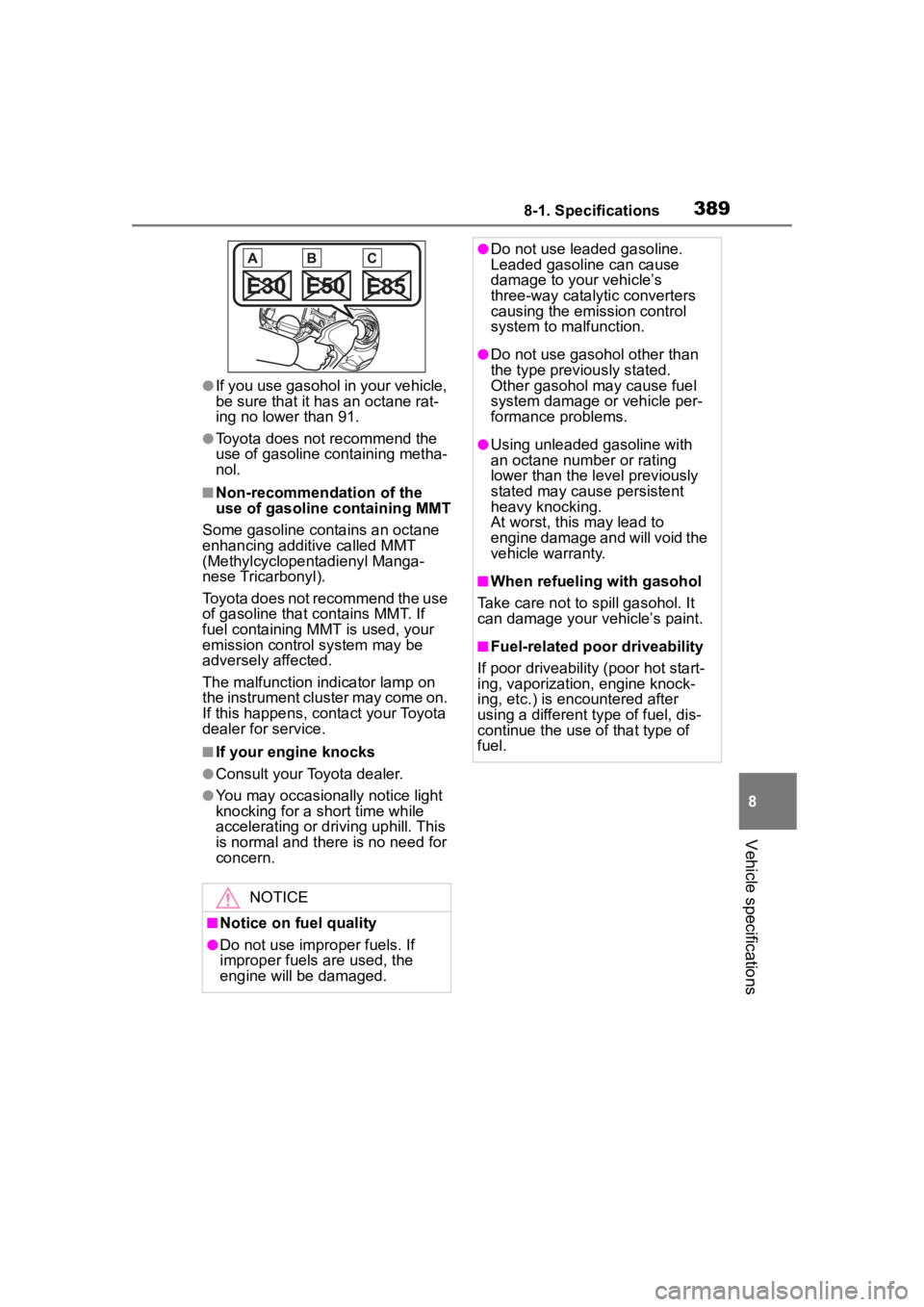
3898-1. Specifications
8
Vehicle specifications
●If you use gasohol in your vehicle,
be sure that it has an octane rat-
ing no lower than 91.
●Toyota does not recommend the
use of gasoline co ntaining metha-
nol.
■Non-recommendation of the
use of gasoline containing MMT
Some gasoline contains an octane
enhancing additive called MMT
(Methylcyclopentadienyl Manga-
nese Tricarbonyl).
Toyota does not recommend the use
of gasoline that contains MMT. If
fuel containing MMT is used, your
emission control system may be
adversely affected.
The malfunction indicator lamp on
the instrument cluster may come on.
If this happens, contact your Toyota
dealer for service.
■If your engine knocks
●Consult your Toyota dealer.
●You may occasionally notice light
knocking for a short time while
accelerating or dr iving uphill. This
is normal and there is no need for
concern.
NOTICE
■Notice on fuel quality
●Do not use impro per fuels. If
improper fuels are used, the
engine will be damaged.
●Do not use leaded gasoline.
Leaded gasoline can cause
damage to your vehicle’s
three-way catalytic converters
causing the emission control
system to malfunction.
●Do not use gasoho l other than
the type previously stated.
Other gasohol may cause fuel
system damage or vehicle per-
formance problems.
●Using unleaded gasoline with
an octane number or rating
lower than the level previously
stated may cause persistent
heavy knocking.
At worst, this may lead to
engine damage and will void the
vehicle warranty.
■When refueling with gasohol
Take care not to spill gasohol. It
can damage your vehicle’s paint.
■Fuel-related poor driveability
If poor driveability (poor hot start-
ing, vaporization, engine knock-
ing, etc.) is encountered after
using a different type of fuel, dis-
continue the use of that type of
fuel.
Page 430 of 449

430Alphabetical Index
Fixed with a seat belt ............. 67
Front passenger occupant clas-sification system ................... 56
Points to remember ................ 64
Riding with children ................ 63
Types of child restraint system installation met hod ............... 66
Using an anchor bracket ........ 73
Child safety Battery precautions ...... 311, 374
Child restraint system............. 66
How your child should wear the seat belt................................ 26
Power window lock switch.... 130
Removed electronic key battery precautions......................... 329
Seat belt precautions ............. 63
Seat heater precautions ....... 276
Trunk precautions................. 107
Cleaning Exterior ................................. 288
Interior .......................... 291, 293
Seat belts ............................. 291
Wheels and wheel ornaments........................................... 288
Clock ................................... 88, 91
Condenser .............................. 308
Console box ............................ 280
Conventional Cruise Control207, 255
Cooling system ...................... 307 Engine overheating .............. 375
Cruise control Adaptive Cruise Control ....... 190
Conventional Cruise Control207, 255
Cup holders ............................ 281
Current fuel consumption ....... 94
Curtain shield airbags ............. 29
Customizable features ........... 400D
Daytime running light system158
Daytime running lights Replacing light bulbs ............334
Defogger Outside rear view mirrors .....272
Rear window.........................272
Windshield ............................272
Dimension ...............................380
Dinghy towing .........................144
Display Driving information .................94
Multi-information display.........93
Display change button .............90
Do-it-yourself maintenance ...296
Door courtesy lights...............277
Door lock Doors ....................................105
Smart key system ................. 111
Wireless remote control........103
Doors Door glasses ........................129
Door lock ..............................105
Open door warning buzzer ...106
Open door warning light .......351
Outside rear view mirrors .....127
Driving Break-in tips .........................133
Correct driving posture ...........23
Driving mode select switch ...258
Procedures ...........................132
Winter drive tips....................266
Driving distance........................94
Driving information ..................94
Driving information display .....94
Driving range ............................94
Driving time ...............................94
E
EDR (Event data recorder) .........7
Page 432 of 449

432Alphabetical Index
Pre-Collision Throttle Manage-ment ................................... 215
Temporary stop .................... 228
F
Flat tire Tire pressure warning system........................................... 315
Vehicles without a spare tire 358
Floor mats ................................. 22
Fluid Automatic transmission ........ 384
Brake ............................ 308, 385
Clutch ................................... 308
Manual transmission ............ 385
Washer ................................. 311
Front passenger occupant clas- sification system .................... 56
Front position lights Wattage ................................ 387
Front seats Adjustment ........................... 119
Cleaning ....................... 291, 293
Correct driving posture ........... 23
Head restraints ..................... 123
Seat heaters ......................... 276
Front side marker light Light switch .......................... 158
Front turn signal lights Replacing light bulbs ............ 334
Turn signal lever ................... 155
Wattage ................................ 387
Fuel Capacity ............................... 381
Fuel gauge ............................. 88
Fuel pump shut off system ... 347
Information ........................... 388
Refueling .............................. 167
Type ..................................... 381
Warning light ........................ 351 Fuel filler door
If the fuel filler door cannot be opened ...............................369
Refueling ..............................167
Fuel gauge.................................88
Fuel pump shut off system ....347
Fuses .......................................330
G
Gauges ......................................88
G-force .......................................96
Glove box ................................279
H
Head restraints .......................123
Headlight aim ..........................332
Headlights High Beam Assist system .....162
Light switch...........................158
Replacing light bulbs ............334
Wattage ................................387
Heaters Automatic air conditioning sys-tem .....................................270
Outside rear view mirrors .....272
Seat heaters ....... ..................276
High Beam Assist ...................162
High mounted stoplight Replacing light bulbs ............334
Hill-start assist control...........262
Hood Open.....................................302
Hooks Retaining hooks (floor mat) ....22
Horn .........................................125
I
I/M test .....................................299
Identification Engine ..................................381